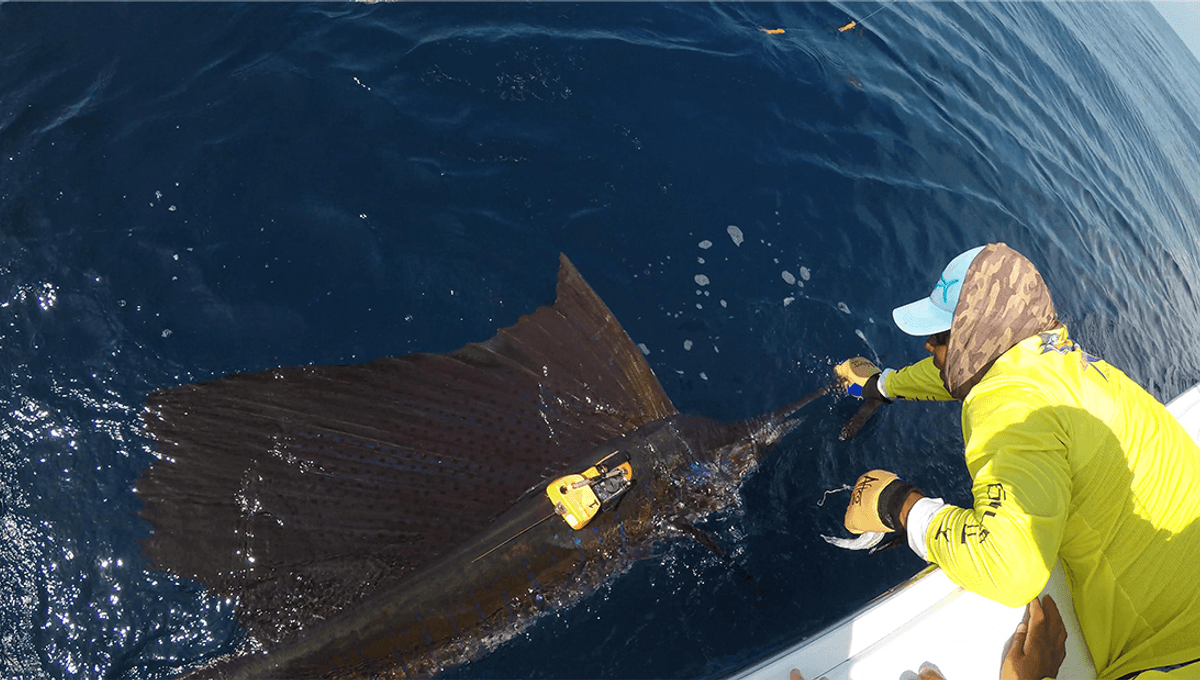
Unsurprisingly, studying what most experts consider to be the fastest fish in the ocean is a challenge. Sailfish (Istiophorus platypterus) belong to a group of fishes called billfishes, which also include marlins and spearfishes. Famous for their unique appearance, power, and their high-speed predatory behavior, little has been discovered about how solitary sailfish hunt, largely because we haven’t been able to keep up, until now.
In groups of sailfish, there are well-documented cases of bait-ball hunting where a group of sailfish will drive a ball of prey fish to the surface of the ocean. Then, individuals will be able to enter the trapped bait-ball to feed. However, apart from this one group hunting technique, sailfish are mostly considered to be solitary roaming predators.
Sailfish are thought to have a high metabolic rate because of their size, however this has not been studied because sailfish are extremely difficult to keep in captivity. In a new study, researchers were able to fit an individual sailfish in the Eastern Tropical Pacific with an animal-borne datalogger, complete with video, to monitor what the sailfish got up to over a 24-hour period.
The researchers were able to record the sailfish hunting a tuna, representing the first time footage of solitary sailfish hunting has been recorded.
The sailfish made multiple efforts to capture the tuna, which even tried to “hide” by swimming close to the sailfish and therefore not being visible to it, in the sailfish’s peripheral vision. While the video does not show if the sailfish caught the tuna, (because you can’t see the mouth of the fish) after 60 seconds the sailfish does a “head shake” which the researchers say often indicates swallowing or prey manipulation, suggesting the sailfish successfully caught the tuna.
While sailfish are believed to be one of the fastest fish in the world with a top speed of around 8.2 meters per second (0.005 miles per second), this individual only achieved a max speed of 3.1 meters per second (0.002 miles per second) during the chase with the tuna. However, the team think that it is to allow the sailfish more maneuverability as it chases the tuna at a lower speed, rather than swimming as fast as possible but not being able to keep up with the swift turns and changes of direction of the prey.
Overall, the team present the first-of-its-kind recording of a sailfish hunting event along with over 24 hours of individual behavior data and active metabolic rate estimations. They suggest that the research could be used as a starting point to improve the understanding of these impressive ocean predators.
“This research improves our understanding of the hidden lives of these majestic, ecologically and economically very important fishes,” said Dr Mahmood Shivji, a co-author of the study and Director of Nova Southeastern University’s Guy Harvey Research Institute in a statement. “Such knowledge is essential to help us better protect the health of these fish and their prey to have a sustainable sportfish industry for many years to come.”
The paper is published in Scientific Reports.
Source Link: Watch Footage Of The World’s Fastest Fish Hunting – For The First Time